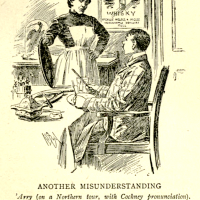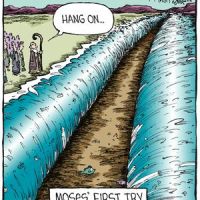 Years ago I remember watching the Val Kilmer film At First Sight. I’ve attached the trailer below; it is a basic boy-meets-girl story with an intriguing premise. A fifty-year-old man has been blind since childhood, but is offered sight through a revolutionary new medical procedure. The operation is a success, but the results are startling. The man has no interpretive lens for understanding light–the stimuli are startling and overwhelming. As material objects before him come to light, he has to slowly learn to appreciate depth, colour, shadow, and distance. As the man struggles to live within his newly lit world, he is uncertain whether sight is a blessing or a curse.
Years ago I remember watching the Val Kilmer film At First Sight. I’ve attached the trailer below; it is a basic boy-meets-girl story with an intriguing premise. A fifty-year-old man has been blind since childhood, but is offered sight through a revolutionary new medical procedure. The operation is a success, but the results are startling. The man has no interpretive lens for understanding light–the stimuli are startling and overwhelming. As material objects before him come to light, he has to slowly learn to appreciate depth, colour, shadow, and distance. As the man struggles to live within his newly lit world, he is uncertain whether sight is a blessing or a curse.
The film is based upon neurologist Oliver Sacks’ New Yorker story, “To See and Not See,” a story that challenged the popular understanding of sight. But I wonder if the roots for the story run deeper.
From the fickle fates of history, two C.S. Lewis manuscripts have emerged of the same unpublished short story. One, bound in a notebook rescued from a bonfire by Walter Hooper, was published in 1977 under the title “The Man Born Blind.” In the aftermath of this publication–and in the context of  heated accusations of forgery–a second version of the story appeared. A manuscript in Lewis’ hand of the story “Light” appeared in British bookseller circles in the mid-1980s and was purchased by American collector Edwin W. Brown. While the two versions are quite similar, we have not had access to “Light” until Professor Charlie Starr published it in his excellent book Light: C.S. Lewis’s First and Last Short Story,with the full manuscript history (see my review here).
heated accusations of forgery–a second version of the story appeared. A manuscript in Lewis’ hand of the story “Light” appeared in British bookseller circles in the mid-1980s and was purchased by American collector Edwin W. Brown. While the two versions are quite similar, we have not had access to “Light” until Professor Charlie Starr published it in his excellent book Light: C.S. Lewis’s First and Last Short Story,with the full manuscript history (see my review here).
While I do not find the story of Light/The Man Born Blind to be Lewis’ best work–there may be a reason they were never published in his lifetime–the premise is intriguing. A man named Robin, blind from birth, has been given sight through a revolutionary new medical procedure. Robin is able to appreciate his new world, and within weeks he has begun to read and to take walks on his own. What he doesn’t understand, though, is the concept of “light.”
Through his life, he had read poetry about light, and could only imagine the richness of the experience. Consistently he heard how people talked about light: “you are standing in my light,” or “what  lovely light on the hill over there.” But when he looked around him, he could not see this thing they called “light.” He asked his wife about it, and after her initial confusion, she pointed to the lightbulb in the ceiling. But this pale source of light was not what Robin meant: he yearned for light, the substance that poets and loved ones described to him his whole life. His wife cannot understand, though, and begins to think he is mad.
lovely light on the hill over there.” But when he looked around him, he could not see this thing they called “light.” He asked his wife about it, and after her initial confusion, she pointed to the lightbulb in the ceiling. But this pale source of light was not what Robin meant: he yearned for light, the substance that poets and loved ones described to him his whole life. His wife cannot understand, though, and begins to think he is mad.
Eventually, Robin begins to despair.
“He was beginning to suspect that most of the un-blind were in the same position. What one heard among them was probably mere parrot-like repetition of a rumour–a rumour concerning something which the very few, the great poets and prophets, had really seen and known. Somewhere it must exist. Perhaps not in England–perhaps only rare deposits of it existed, far away to the East in deserts or high mountains” (Charlie Starr, Light, 8).
Robin begins to obsess over the idea of “light.” He knows he cannot bring it up with his wife or his doctors–they would not understand, and might commit him to an asylum. So Robin takes what seems to be an innocent walk, but what is reall a determined search to find light.
“[Perhaps] he would never see it. But if he did–ah yes, if–he would dive into its very heart, give all himself away to it, drink, drink, drink it till he died drinking” (8).
Robin walks into the early morning, searching for “light” as the sun rises and burns away the mist. He finally comes to an artist painting a canyon landscape. Robin doesn’t understand what the man is up to–visual art would be a complete mystery to him, of course, not least the production of that art. Curious, he asks the man what he is doing.
“‘Doing?’ said the stranger with a certain light-hearted savagery. ‘Doing? I’m trying to catch light, if you want to know. Damn it.’
“‘Good God! So am I,’ said Robin.
“‘Oh–you know too, do you?’ said the man…. “And yet this is the only sort of day when you can see light–solid light–light you could drink in a cup or swim in! Look at it!'” (8).
Robin did look. He saw that “the fog was at death grips with the sun,” a “bath of vapour” unfolding “itself in ever widening spirals towards them.” Robin saw the “light” he desired all along, and as he promised, he threw himself into it. Literally.
Robin jumped into the canyon and fell through the morning fog to his death.
“From a new-made and rapidly vanishing rift in the fog beneath him there came up no cry but only a sound so sharp and definite that you would hardly expect it to have been made by the fall of anything so soft as a human body: that, and the momentary rattling of a dislodged stone” (9).
The macabre ending aside–obviously Lewis is doing something in the world of word pictures with this story–the entire set up is intriguingly similar to Sacks’ own short story. I find it unlikely that  Sacks was influenced by this virtually unknown story–even though the main character in Sacks’ story is called “Virgil,” one of Lewis’ most-quoted poets. Sacks’ imagination about how one would experience sight comes from his neurological work, from his direct experience in the field. At best, Lewis’ naive picture of man gaining the “gift” of sight to discover it only as a curse is a curious, but accidental imagination of a writer in his study some decades before science could give him hints about the matter. Rehabilitation of the blind who receive sight is often a lengthy process.
Sacks was influenced by this virtually unknown story–even though the main character in Sacks’ story is called “Virgil,” one of Lewis’ most-quoted poets. Sacks’ imagination about how one would experience sight comes from his neurological work, from his direct experience in the field. At best, Lewis’ naive picture of man gaining the “gift” of sight to discover it only as a curse is a curious, but accidental imagination of a writer in his study some decades before science could give him hints about the matter. Rehabilitation of the blind who receive sight is often a lengthy process.
There is one story, however, that I can’t help wonder if it haunts behind them both. One cannot think of “revolutionary medical procedures” without thinking of the word “miracle.” Jesus did a number of healings in the gospels, but one of them stands out from among the rest:
Mark 8:22 They came to Bethsaida, and some people brought a blind man and begged Jesus to touch him. 23 He took the blind man by the hand and led him outside the village. When he had spit on the man’s eyes and put his hands on him, Jesus asked, “Do you see anything?”
24 He looked up and said, “I see people; they look like trees walking around.”
25 Once more Jesus put his hands on the man’s eyes. Then his eyes were opened, his sight was restored, and he saw everything clearly. 26 Jesus sent him home, saying, “Don’t even go into the village.”
We don’t know this un-blind man’s story. I suspect he told someone–it would be obvious to anyone who knew him. But what is fascinating is how this story hints at the gap between “miracle” and “healing” in the two 2oth century stories above. The healing story is probably told here in Mark to remind us that the often perplexed disciples need a second touch in order to see Jesus’ strange purposes. Importantly, though, this story addresses the blind man’s perceptual struggles, and Jesus performs a second healing that brings together healing and miracle. Jesus heals him in such a way that he can “see light.” The disciples, by contrast, take a little longer.
The biblical blind man’s story does not end as it does in Lewis’ or Sacks’ stories. In At First Sight, sight is a curse and blindness tempts again. In “Light,” Robin never comes to grips with what light really is–it is, after all, not something that can be easily “gripped.” I can’t imagine any of the three scenarios, really, but what they all remind me is that there is a clear difference between “seeing” and “being able to see.”






















Pingback: Shedding Light on Lost Manuscripts: A Review of Charlie Starr’s “Light” | A Pilgrim in Narnia
Pingback: The Society of Tim | A Pilgrim in Narnia
Pingback: A Thing of Forms Unknown: Thoughts on C.S. Lewis and Horror with Chris Calderon (Happy Hallowe’en!) | A Pilgrim in Narnia